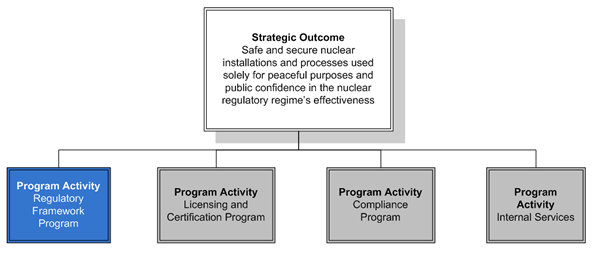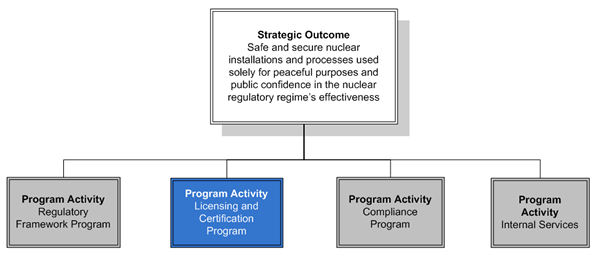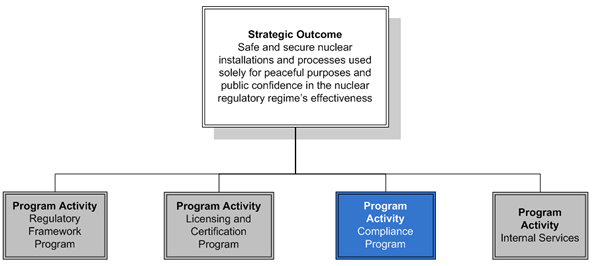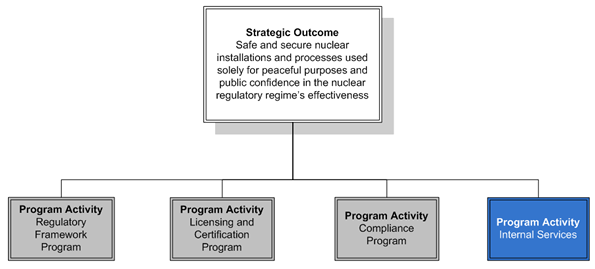Common menu bar links
Breadcrumb Trail
ARCHIVED - Canadian Nuclear Safety Commission - Report
 This page has been archived.
This page has been archived.
Archived Content
Information identified as archived on the Web is for reference, research or recordkeeping purposes. It has not been altered or updated after the date of archiving. Web pages that are archived on the Web are not subject to the Government of Canada Web Standards. As per the Communications Policy of the Government of Canada, you can request alternate formats on the "Contact Us" page.
Section II – Analysis of Program Activities by Strategic Outcome
2.1 Strategic Outcome
The Canadian Nuclear Safety Commission has a single strategic outcome: safe and secure nuclear installations and processes used solely for peaceful purposes and public confidence in the nuclear regulatory regime’s effectiveness. To support this outcome, the CNSC has four program activities: regulatory framework; licensing and certification; compliance; and internal services.
The following section describes the CNSC’s program activities and identifies the expected results, performance indicators and targets for each of them. This section also explains planning highlights and benefits for Canadians, and presents the financial and non-financial resources that will be dedicated to each activity.
2.1.1 Program Activity: Regulatory Framework

| Human Resources (FTEs) and Planned Spending ($ thousands) | |||||
|---|---|---|---|---|---|
| 2011-12 | 2012-13 | 2013-14 | |||
| FTEs | Planned Spending | FTEs | Planned Spending | FTEs | Planned Spending |
| 103 | 19,083 | 103 | 18,663 | 103 | 18,989 |
| Program Activity Expected Results | Performance Indicators | Targets |
|---|---|---|
| A clear and pragmatic regulatory framework. | Satisfaction levels of stakeholders across key performance areas. | Target: Increasing trend in survey results over a three-year period, stable thereafter. |
| Number of legal challenges to the regulatory framework. | Target: Minimal/declining number of challenges and/or high success rate of defending challenges. |
Program Activity Description
The Regulatory Framework program is in place to ensure that Canadians—and licensees, in particular—have a clear and pragmatic regulatory framework for the nuclear industry in Canada.
Funds are used to develop and make amendments to elements of the regulatory framework (such as the Nuclear Safety Control Act and regulations under the Act; regulatory documents, such as policies, standards and guides; the Safeguards Agreement and Additional Protocol between Canada and the International Atomic Energy Agency, and Canada’s bilateral Nuclear Cooperation Agreements) that protect the health, safety, security, and environment for Canadians, while implementing Canada’s international commitments on the non-proliferation of nuclear weapons and the peaceful use of nuclear energy.
The CNSC also administers the Nuclear Liability Act and, as a Responsible Authority under the Canadian Environmental Assessment Act, carries out environmental assessments for nuclear projects in accordance with this legislation.
The following table aligns the Regulatory Framework Planning Highlights with their corresponding organizational priorities, and presents the planned timeline for completion:
| Planning Highlights | Timeline for Completion |
|---|---|
| Core regulatory operations | |
|
Continue modernization of the Regulatory Framework with respect to new major projects such as nuclear power plants and uranium mines:
|
June 2012 |
|
Establish and implement Administrative Arrangements (AAs), pursuant to Canada’s bilateral Nuclear Cooperation Agreements (NCAs) to respond to changes in international nuclear trade and to enhance effectiveness in implementation of export and import licensing controls: |
|
|
Expected completion by March 31, 2012. |
| Negotiate and implement bilateral harmonization AAs with countries that import Canadian-origin category 1 and 2 radioactive sources (India, Russia, Latin America). | Make substantive progress in 2012. |
|
Organizational Priority: Commitment to ongoing improvements |
|
| Continue to work with Major Projects Management Office (MPMO) partners to coordinate regulatory review processes related to major nuclear projects. | Ongoing |
| Implement the strategy for a renewed CNSC Research Program. | December 31, 2011 |
| Continue to work with the International Atomic Energy Agency (IAEA) to streamline the amount of verification effort in Canada. | Ongoing |
| Undertake preparations for the Integrated Regulatory Review Service (IRRS) follow-up mission in November 2011. | March 31, 2012 |
|
Organizational Priority: Clarity of requirements |
|
|
Complete the Regulatory Framework Plan initiatives scheduled for 2011-12, including: |
|
|
June 30, 2011 |
|
September 30, 2012
|
|
March 31, 2013 |
| Implement strategy for waste management regulation, including tailings management. | March 31, 2012 |
|
Organizational Priority: Communications |
|
|
Strengthen stakeholder engagement and outreach strategy:
|
December 31, 2011 |
|
Continue improving accessibility of information about the CNSC and its work:
|
Ongoing |
Benefits for Canadians
The CNSC maintains an evergreen assessment of the Nuclear Safety and Control Act (NSCA), and continuously works with other national and international organizations to ensure that nuclear energy and materials are regulated effectively. Through its work with these partners, the CNSC is able to share best practices and lessons learned, and maximize its efficiencies.
This program activity also aims to ensure that the CNSC’s non-licensee and non-governmental related stakeholders are informed on the activities, policies, programs and the role of the CNSC, and that they have an opportunity to ask questions and express their views. It provides objective scientific and technical information on the areas regulated by the CNSC, and engages stakeholders, by soliciting their input on regulatory issues to enhance the quality of the organization’s work and decisions. Licensees and government stakeholders (both domestic and international) are also appropriately informed about, and/or consulted on the role, activities, policies, and programs of the CNSC. An informed and engaged public is an important element of an open and balanced review process, and strengthens the quality and credibility of regulatory reviews and subsequent decisions.
Regulatory Framework – The Bottom Line
The Regulatory Framework Program Activity results in a continuously reviewed, modern, transparent regulatory framework that is open and accessible to licensees and stakeholders, and that is focussed on nuclear safety and security, and on effectively implementing relevant international obligations.
No compromise.
2.1.2 Program Activity: Licensing and Certification

| Human Resources (FTEs) and Planned Spending ($ thousands) | |||||
|---|---|---|---|---|---|
| 2011-12 | 2012-13 | 2013-14 | |||
| FTEs | Planned Spending | FTEs | Planned Spending | FTEs | Planned Spending |
| 191 | 24,788 | 191 | 24,093 | 191 | 24,408 |
| Program Activity Expected Results | Performance Indicators | Targets |
|---|---|---|
| Individuals, organizations, and prescribed equipment that operate safely and comply with all regulatory requirements. | Number of licences and certificates issued as per service standards. | Target: Meet external performance standards. |
|
The CNSC publishes the annual results for a full suite of External Performance Standards related to Licensing, Certification, and Compliance. This additional performance information can be found online in the following CNSC reports: |
Program Activity Description
The Licensing and Certification program is in place to issue licences or certify persons, organizations, and prescribed equipment for conducting nuclear-related activities in Canada.
With this program activity’s funding, the CNSC obtains evidence of the applicant licensees’ ability to operate safely and comply with all regulatory requirements.
The CNSC undertakes this work to obtain assurance that nuclear activities and facilities in Canada are managed with adequate provision for protection of health, safety, security and the environment and the fulfillment of international commitments to the peaceful use of nuclear energy.
The following table aligns the Licensing and Certification Planning Highlights with their corresponding organizational priorities, and presents the planned timeline for completion:
| Planning Highlights | Timeline for Completion |
|---|---|
| Core regulatory operations | |
| Conduct licensing and certification activities according to plans. | March 31, 2012 |
|
Conduct regulatory oversight of new major projects: |
|
|
March 31, 2012 |
|
Fall 2011 |
|
March 31, 2012 |
|
March 31, 2012 |
|
March 31, 2012 |
|
Undertake regulatory reviews of applications for licence renewals including: |
|
|
April 2011 |
|
September 2011 |
|
December 2011 |
|
Continue regulatory oversight of the Port Hope Area Initiative:
|
June 2011 |
|
Undertake regulatory reviews of applications for non-reactor production of medical isotopes:
|
December 31, 2011 |
|
Organizational Priority: Commitment to ongoing improvements |
|
| Strengthen the manner in which technical assessments are performed to ensure a consistent approach across all areas of the CNSC. | Ongoing |
|
Organizational Priority: Clarity of requirements |
|
|
Continue pre-project vendor design reviews of:
|
March 2012 |
|
Develop Licence Condition Handbook for nuclear facilities (at each licence renewal):
|
March 2012 |
|
Organizational Priority: Capacity for action |
|
|
Provide regulatory oversight to life-extension projects:
|
Ongoing |
Benefits for Canadians
This program activity is central to meeting the CNSC’s mandate by ensuring that applicants for licences and certificates fully meet the requirements of the NSCA and associated regulations before they are permitted to engage in any nuclear-related activity.
Applications for licences and certificates are scrutinized by CNSC staff who make sure that the proposed activities in question meet the regulatory requirements of the Nuclear Safety and Control Act, its associated regulations and licences. A licence or certificate will only be issued once the CNSC is certain that licensees are prepared to meet all regulatory requirements.
Licensing and Certification – The Bottom Line
Licences and certificates will only be issued once the CNSC has determined that licensees are positioned to conduct their activities with the utmost attention to health, safety, security, protection of the environment and the requirements of relevant international obligations.
No compromise.
2.1.3 Program Activity: Compliance

| Human Resources (FTEs) and Planned Spending ($ thousands) | |||||
|---|---|---|---|---|---|
| 2011-12 | 2012-13 | 2013-14 | |||
| FTEs | Planned Spending | FTEs | Planned Spending | FTEs | Planned Spending |
| 245 | 36,674 | 245 | 38,437 | 245 | 39,101 |
| Program Activity Expected Results | Performance Indicators | Targets |
|---|---|---|
| A high level of compliance by licensees with the regulatory framework. | Degree/level of reconciliation between Canada and other countries to nuclear inventories subject to bilateral Nuclear Cooperation Agreements (NCAs). | Target: 100% of Annual Inventory Reports received from foreign bilateral counterparts are reviewed annually and inventory reconciliation issues identified and addressed. |
| Nuclear substances, equipment and technology exported from Canada remain in peaceful use. | Effective enforcement actions taken on unauthorized exports/imports detained or seized at border points. | Target: 100% of detentions and seizures at border addressed through corrective actions. |
| Adherence with Sealed Source Tracking requirements. | Target: 100% on time; 100% match with registry. | |
| Nuclear material “ledger” reconciliations between the CNSC and licensees. | Target: Identical inventory records on reconciliation of nuclear material. | |
| Frequency and severity rate of accidents. | Target: Zero. | |
|
In addition to the above indicators, the CNSC publishes the annual results for a full suite of External Performance Standards related to Licensing, Certification, and Compliance. This additional performance information can be found online in the following CNSC reports:
|
Program Activity Description
The Compliance program is in place to ensure that CNSC licensees exhibit a high level of compliance with the CNSC’s regulatory framework. This program enables the CNSC to provide regulatory assurance to Canadians of the continuing compliance and safety performance of licensees.
This program activity’s funding is used for the promotion of compliance, safety culture and common safety values, compliance inspections, and enforcement actions.
The following table aligns the Compliance Planning Highlights with their corresponding organizational priorities, and presents the planned timeline for completion:
| Planning Highlights | Timeline for Completion |
|---|---|
| Core regulatory operations | |
| Conduct inspections according to plans. | Ongoing |
|
Undertake regulatory oversight of refurbishment projects:
|
Ongoing |
| Undertake regulatory oversight to support Canada’s obligations on the peaceful use of nuclear material, equipment and technology. | Ongoing |
| Implement the requirements of the Canada-IAEA Safeguards agreement and Additional Protocol. | Ongoing |
|
Organizational Priority: Commitment to ongoing improvements |
|
| Strengthen inspection procedures to ensure there is a consistent approach to inspection of all nuclear facilities and activities. | Ongoing |
| Continue to work with the IAEA to identify and implement more efficient approaches and procedures to improve safeguards efficiencies and maintain required levels of effectiveness, while reducing on-site effort by the IAEA, licensees and the CNSC. | Ongoing |
| Work with national and international partners to strengthen Canada’s counter-proliferation framework. | Ongoing |
|
Organizational Priority: Clarity of our requirements |
|
| Strengthen the CNSC’s intelligence network with all licensees. | Ongoing |
|
Organizational Priority: Capacity for action |
|
| Obtain industry standard certification for the CNSC Laboratory: |
|
|
2011-12 |
|
2012-13 |
|
Organizational Priority: Communications |
|
| Continue promotion of the CNSC’s nuclear safety brand. | Ongoing |
Benefits for Canadians
Through numerous inspections of nuclear facilities, activities and processes, as well as through the review of licensee reports, the CNSC continuously monitors the Canadian nuclear industry to make sure that licensees are operating safely, securely, and in compliance with the requirements set out in the Nuclear Safety and Control Act, its associated regulations, licences and certificates.
In cases of non-compliance, the CNSC will use various enforcement actions, in a graded approach, to ensure that licensees take corrective action and may, in certain situations, call licensees before the Commission. Enforcement actions taken by the CNSC can range from issuing a written notice for corrective actions for minor infractions to issuing orders, recommending licensing actions (including suspension and revocation) or withdrawal of certification or prosecution for more serious violations.
The CNSC regularly communicates the status of nuclear industry compliance to Canadians through reports published on its Web site. These reports cover a variety of topics related to the Canadian nuclear industry, including: uranium mining, radioactive releases, the safety performance of nuclear power facilities, and the tracking and reporting of lost or stolen sealed sources and radiation devices.
Compliance – The Bottom Line
The CNSC can assure Canadians that its licensees are operating safely and securely in compliance with their licences, certificates, regulations, and underlying legislation, as well as with international obligations and bilateral agreements, and that exports of nuclear substances, equipment and technology are used for peaceful purposes only.
No compromise.
A brief description of the main types of compliance activities conducted by the CNSC follows in the information box below:
Our Daily Activities
The majority of the CNSC’s work involves undertaking licensing and compliance activities in a risk-informed fashion, to ensure that licensees meet regulatory requirements set out in regulations and in their licences. This requires maintaining an adequate level of regulatory vigilance, and being prepared to react according to credible information received.
Much of the compliance work is in the form of various types of inspections.
- Type I inspections are systematic and documented processes — similar to audits or program evaluations — to determine, through objective evidence, if licensee programs, processes or practices comply with regulatory requirements.
- Type II inspections are planned and documented activities to verify the results of licensee processes, not the processes themselves. They are typically routine (item-by-item) inspections and rounds, usually of specified equipment, facility material systems, or of discrete records, products or outputs from licensee processes.
- Desktop reviews are the CNSC staff analyses of compliance reports submitted by licensees, in order to evaluate if licensees are complying with the regulatory requirements.
Typically, in a fiscal year, the CNSC will undertake approximately 50 Type I inspections, 1,800 Type II inspections and numerous desktop reviews.
2.1.4 Program Activity: Internal Services

| Human Resources (FTEs) and Planned Spending ($ thousands) | |||||
|---|---|---|---|---|---|
| 2011-12 | 2012-13 | 2013-14 | |||
| FTEs | Planned Spending | FTEs | Planned Spending | FTEs | Planned Spending |
| 236 | 37,719 | 236 | 38,519 | 236 | 39,216 |
| Program Activity Expected Results |
|---|
| Activities and resources administered to support the needs of programs and other corporate obligations. |
Program Activity Description
Internal services are activities and resources that apply across the organization to support directly and indirectly program delivery and meet other corporate obligations of the Commission, as an agency of government.
These activities are: Management and Oversight (including Audits and Evaluations); Communications; Legal Services; Human Resources Management; Financial Management; Information Management; Information Technology; Real Property and Materiel Acquisition; Travel and Other Administrative Services.
The following table aligns the Internal Services Planning Highlights with their corresponding organizational priorities, and presents the planned timeline for completion:
| Planning Highlights | Timeline for Completion |
|---|---|
|
Organizational Priority: Commitment to ongoing improvements |
|
|
Continue Service Level and Policy Improvements in support of Harmonized Plan:
|
March 31, 2012 |
| Implement the Management Accountability Framework (MAF) Action Plan in response to Round VII Assessment. | March 31, 2013 |
| Develop a Performance Management Framework for Internal Services. | March 31, 2012 |
|
Organizational Priority: Capacity for action |
|
| Implement the Financial Guarantees strategy. | September 2011 and ongoing. |
| Continue improvements to the Revenue Spending Authority Regime through legislative changes, further reporting integration, more critical analyses and simplified costing methods. | Ongoing |
|
Organizational Priority: Capacity for action |
|
|
Focus Human Resource activities on retention and training in line with Employer of Choice efforts, specifically:
|
March 31, 2012 |
|
Focus information management and technology efforts on the delivery of new solutions to support the regulatory activities of staff, licensees and stakeholders:
|
March 31, 2012 |
| Continue development of, and implement the evaluation function. | September 31, 2011 |
Benefits for Canadians
The above profile of Internal Services reflects a structure applied across government to support a common government-wide approach to planning, design, budgeting, reporting and communications of government internal services.
The Internal Services enable public programs, as well as other internal services, to operate more efficiently and effectively.
At the CNSC, Internal Services is a key mechanism by which the organization becomes better at carrying out its mandate of ensuring the safety and security of the Canadian nuclear industry. This work includes, but is not limited to: making sure the CNSC attracts the right skill sets and provides the right training to its staff; keeping the finances in order; and maintaining up-to-date technology services, and the accessibility of sound legal counsel.
Internal Services – The Bottom Line
The Internal Services program activity results in an effective and responsibly managed organization well positioned to support the achievement of the CNSC’s strategic outcome.
